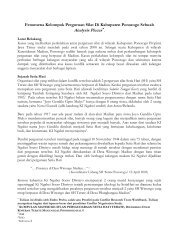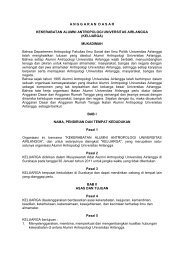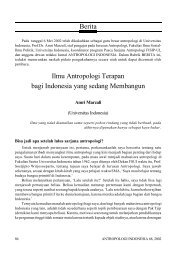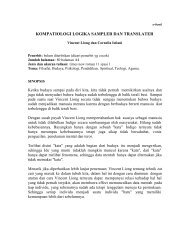The Future of Visual Anthropology: Engaging the Senses
The Future of Visual Anthropology: Engaging the Senses
The Future of Visual Anthropology: Engaging the Senses
Create successful ePaper yourself
Turn your PDF publications into a flip-book with our unique Google optimized e-Paper software.
widijanto judono e-Library collection - widijanto.wordpress.com<br />
situate early anthropological visual images and practices in <strong>the</strong> historical contexts<br />
<strong>of</strong> <strong>the</strong>ir production and viewing. Moreover, Emmison and Smith’s and Rony’s<br />
dependency on a critique <strong>of</strong> colonialism to support <strong>the</strong>ir arguments is self-limiting.<br />
More recently, Edwards’ (2001) discussion <strong>of</strong> a series <strong>of</strong> examples <strong>of</strong> historical<br />
photographs demonstrates that <strong>the</strong> question <strong>of</strong> ‘how photographs and <strong>the</strong>ir making<br />
actually operated in <strong>the</strong> fluid spaces <strong>of</strong> ideological and cultural meaning … cannot<br />
always be encapsulated precisely through <strong>the</strong> mechanisms <strong>of</strong> reception <strong>the</strong>ory,<br />
semiotics or post-colonial deconstruction’ (2001: 3). Instead she recommends a<br />
historical focus on specific acts <strong>of</strong> photographic practice and experience.<br />
Contemporary perspectives on visual research:<br />
a new interdisciplinary field <strong>of</strong> visual methods?<br />
Interdisciplinary agendas 29<br />
Above I have emphasised interdisciplinary competition; <strong>the</strong>re will be more <strong>of</strong> this<br />
later. Never<strong>the</strong>less, a multidisciplinary area <strong>of</strong> interest that centres on uses <strong>of</strong> visual<br />
methods <strong>of</strong> research and representation in social research is developing, represented<br />
in publications and conference meetings. Van Leeuwen and Jewitt’s (2000)<br />
Handbook <strong>of</strong> <strong>Visual</strong> Analysis is a multidisciplinary edited collection with examples <strong>of</strong><br />
visual research methods from psychology, semiotics, cultural studies, anthropology,<br />
and media studies that suggest visual researchers might want to combine not only<br />
different methods but also different disciplinary insights. Rose’s (2001) <strong>Visual</strong><br />
Methodologies also dedicates each chapter to exploring <strong>the</strong> merits and pitfalls <strong>of</strong> a<br />
different disciplinary approach to analysing images. Discussions between visual<br />
researchers <strong>of</strong> different disciplines have been facilitated by <strong>the</strong> <strong>Visual</strong> Evidence<br />
Seminar Series (2000–01). 4 This suggests that visual researchers from different<br />
disciplines share some perspectives and that, in <strong>the</strong> future, visual research may<br />
develop as an interdisciplinary as well as multidisciplinary field, with greater collaboration<br />
between disciplines. In this section I discuss two aspects <strong>of</strong> this: 1) <strong>the</strong> claims<br />
to originality <strong>of</strong> recent texts on visual methods; and 2) <strong>the</strong> common <strong>the</strong>mes that are<br />
embedded in <strong>the</strong>ir arguments and critiques: <strong>the</strong> relationship between <strong>the</strong> content,<br />
context and materiality <strong>of</strong> images; reflexivity and ethics; collaboration and subjectivity/objectivity.<br />
Interpreting visual images<br />
I would argue that in any project a researcher should attend not only to <strong>the</strong> internal<br />
‘meanings’ <strong>of</strong> an image but to how <strong>the</strong> image was produced and how it is made<br />
meaningful by its viewers. Indeed, not attending to all <strong>of</strong> <strong>the</strong>se areas was one <strong>of</strong> <strong>the</strong><br />
pitfalls <strong>of</strong> Rony’s critique <strong>of</strong> Nanook <strong>of</strong> <strong>the</strong> North (page 24). <strong>The</strong>se three areas are<br />
also emphasised by writers on visual methods. For example, Banks (an anthropologist)<br />
summarises that ‘In broad terms social research about pictures involves three<br />
sets <strong>of</strong> questions: (i) what is <strong>the</strong> image <strong>of</strong>, what is its content? (ii) who took it or<br />
made it, when and why? and (iii) how do o<strong>the</strong>r people come to have it, how do <strong>the</strong>y<br />
read it, what do <strong>the</strong>y do with it?’ (2001: 7). Rose (a cultural geographer) draws from










